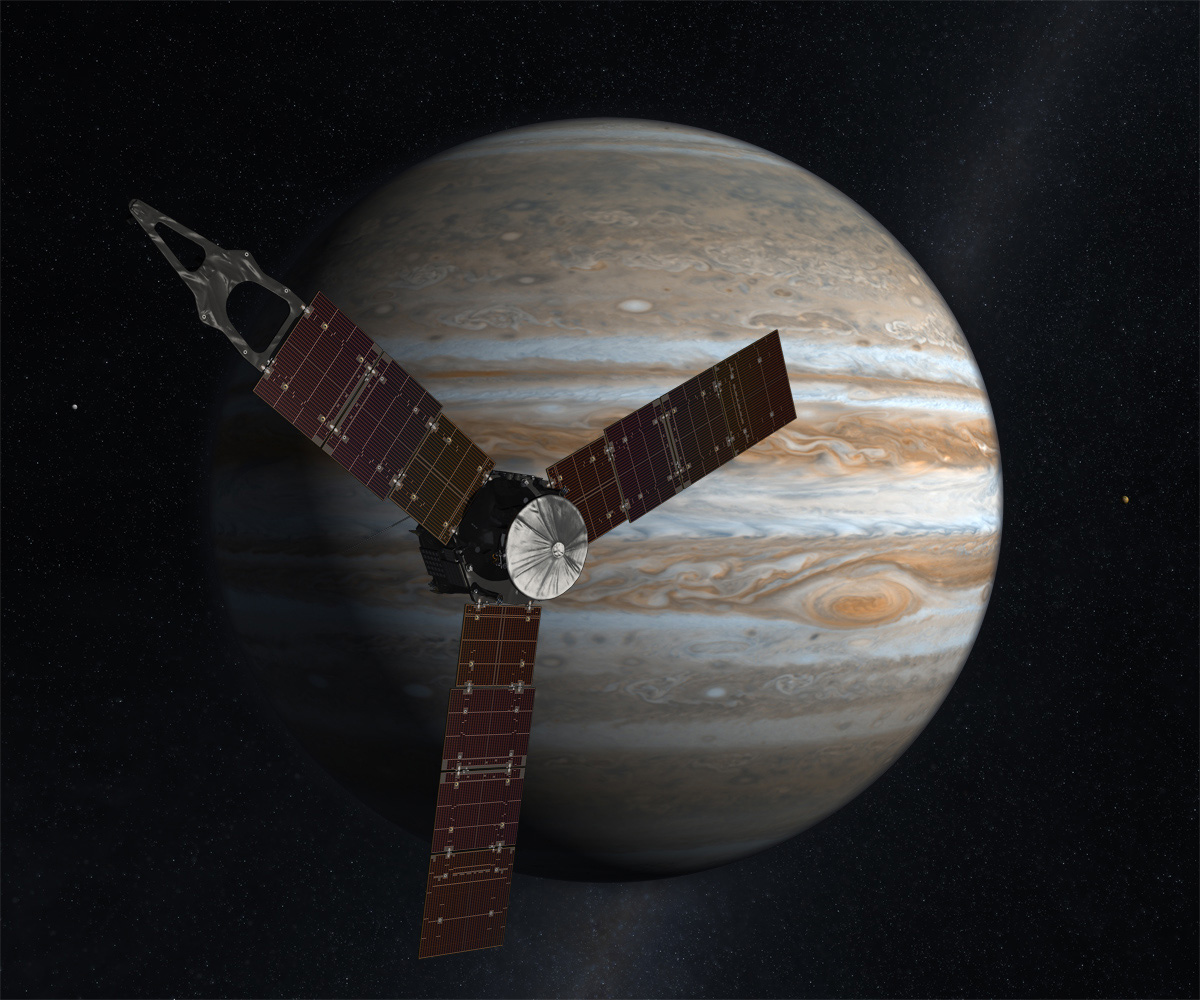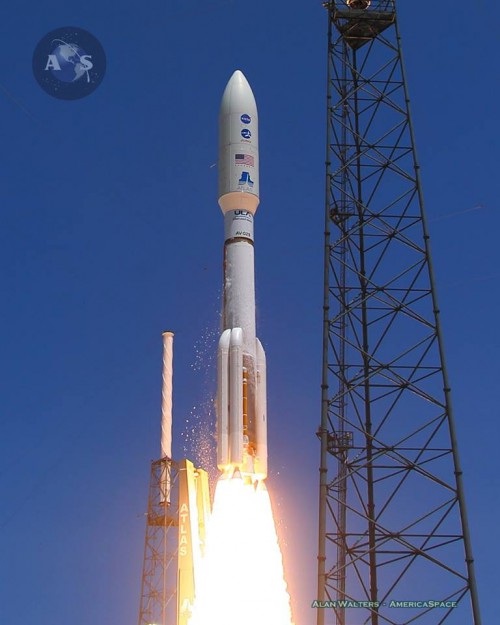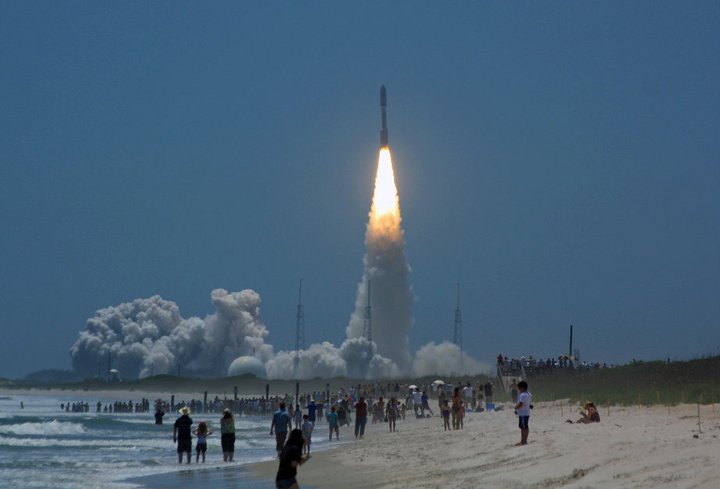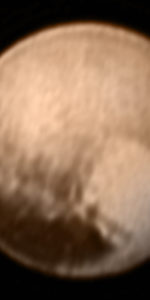
“Jupiter’s welcome to more from his Juno if he can get it.” – Johann Wolfgang von Goethe
While NASA and space enthusiasts the world over are waiting for New Horizons’ unprecedented Pluto flyby, the space agency is gearing up for another planetary encounter to be made in July 2016. Juno, the second New Frontiers mission (the first being New Horizons), is scheduled to arrive at our Solar System’s largest world on July 4 next year. But before the solar-winged spacecraft makes its initial Jovian encounter, engineers and controllers have made some modifications to Juno’s flight plan in order to optimize mapping and science operations.
According to NASA, Juno’s mission objectives include extensively mapping the planet in order to better understand its gravity and magnetic characteristics, which may provide clues into its atmosphere’s water vapor content. In addition, Juno will give scientists their first glances at Jupiter’s polar regions, as the spacecraft will make a series of highly elliptical orbits around the planet. The spacecraft will come within a few thousand miles of the planet’s cloud tops, which will give scientists a look into Jupiter’s atmosphere, as well as what may lurk within it (namely the planet’s core, which is hypothesized to consist of metallic hydrogen).

However, before Juno gets to Jupiter, NASA has divulged some changes made to the spacecraft’s flight plan. Juno will make a shorter engine burn to lengthen its Jovian orbit to 14 days, as opposed to the previous 11 days. NASA stated this change was made to allow the spacecraft to take a “global look” at Jupiter earlier in its mission: “Over successive orbits, Juno will build a virtual web around Jupiter, making its gravity and magnetic field maps as it passes over different longitudes from north to south. The original plan would have required 15 orbits to map these forces globally, with 15 more orbits filling in gaps to make the map complete. In the revised plan, Juno will get very basic mapping coverage in just eight orbits. A new level of detail will be added with each successive doubling of the number, at 16 and 32 orbits.”
The space agency added that these particular changes also were made to give Juno’s team some time to determine how the spacecraft reacts to its close encounter with Jupiter—at the very least, Juno will encounter a strong magnetic field and huge doses of radiation. The orbital change will lengthen Juno’s mission to 20 months, by two orbits (32 versus 30). At the end of Juno’s mission, it will make a “death plunge” into the hostile Jovian atmosphere.
Moreover, Juno’s initial orbit around Jupiter, its “capture orbit,” is being split into two, which will allow the spacecraft to test its science instruments prior to commencing scientific operations. NASA is also preparing for Juno’s close encounters with Jupiter by making observations of the planet via powerful telescopes, including the Hubble Space Telescope. These ground- and space-based observations will give researchers a better prediction of what the spacecraft might see during its mission.
Juno launched aboard a United Launch Alliance Atlas V 551 variant launch vehicle on Aug. 5, 2011, from Cape Canaveral Air Force Station’s Launch Complex 41. The spacecraft completed an Earth flyby on Oct. 10, 2013. Juno’s principal investigator, Scott Bolton of the Southwest Research Institute based out of San Antonio, Texas, discussed the changes in Juno’s plans, and the surprises that lie ahead:
“We’re already more than 90 percent of the way to Jupiter, in terms of total distance traveled. With a year to go, we’re looking carefully at our plans to make sure we’re ready to make the most of our time once we arrive. We have models that tell us what to expect, but the fact is that Juno is going to be immersed in a strong and variable magnetic field and hazardous radiation, and it will get closer to the planet than any previous orbiting spacecraft. Juno’s experience could be different than what our models predict…that’s part of what makes space exploration so exciting.”
This intrepid spacecraft continues NASA’s rich heritage exploring our Solar System’s largest, yet most enigmatic, gas giant. Juno will give the world its closest, most in-depth view of Jupiter since various spacecraft, starting with NASA’s Pioneer 10 performing a “flyby” in 1973, began exploring the outer Solar System planet. Pioneer 11 followed in 1974 with another flyby. Voyagers 1 and 2 both famously visited Jupiter during 1979, investigating the planet, its ring system, and many of its moons; the images returned from these spacecraft remain iconic.
Jupiter has also been investigated by Ulysses, Cassini, and New Horizons (now commencing its Pluto flyby), with Galileo becoming the first Jovian orbiter in the mid-1990s. And in July 2016, NASA and the Jet Propulsion Laboratory will once again visit this Solar System colossus shrouded in mystery, in another historic trek to “sort out the unknowns.”

Be sure to “Like” AmericaSpace on Facebook and follow us on Twitter: @AmericaSpace





2 Comments
2 Pings & Trackbacks
Pingback:Morelos-3 Communications Satellite Destined to Fly Aboard 100th ULA Mission on Friday « AmericaSpace
Pingback:First Hundred, Next Hundred: ULA Celebrates Centenary, Readies For Challenges Ahead « AmericaSpace